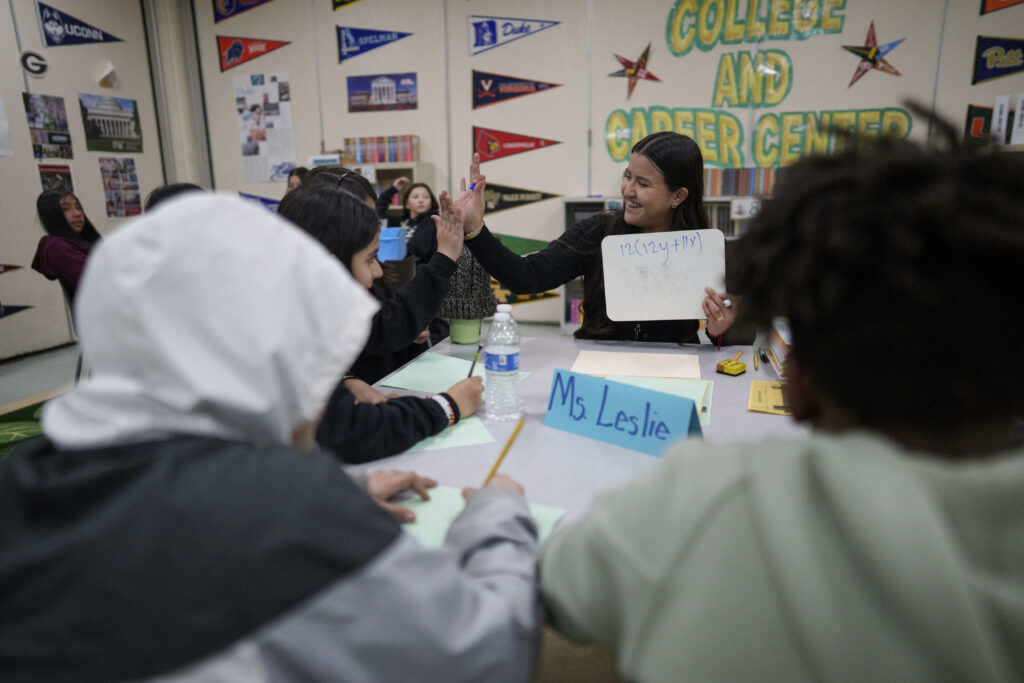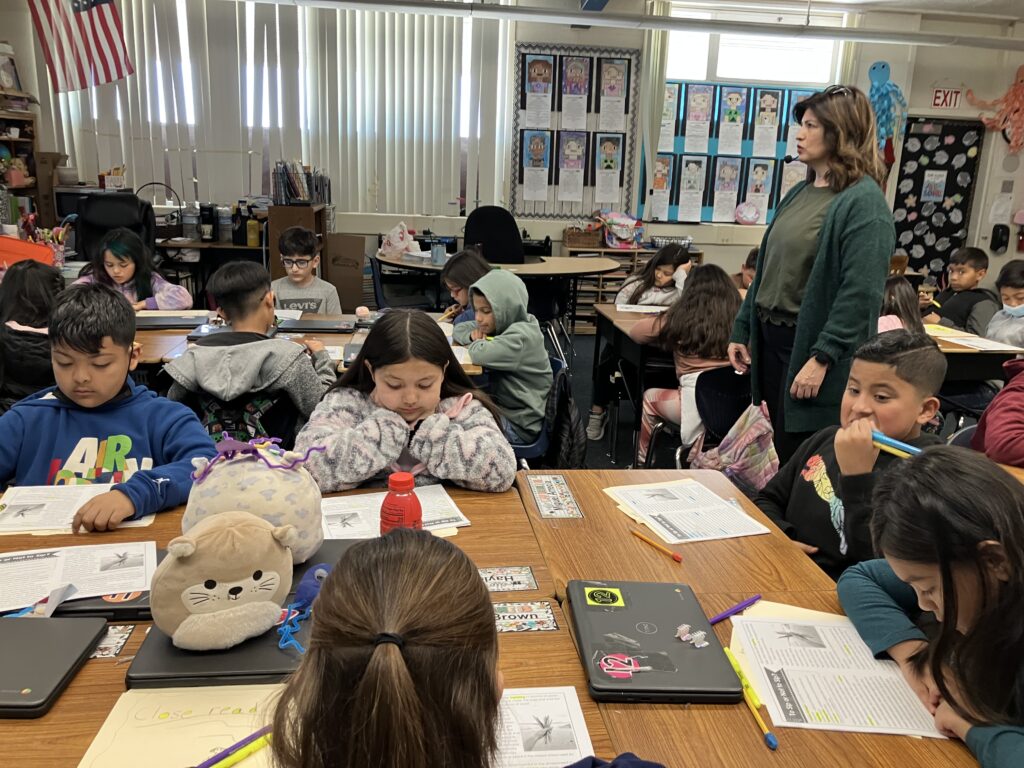
Students in a Fresno Unified classroom.
Credit: Fresno Unified / Flickr
Ending several months of uncertainty, the California State Board of Education on Wednesday chose new labels to describe how students perform on the four levels of achievement on its standardized tests.
The decision was difficult. The 90 minutes of presentations and discussions offered lessons in the subtleties of language and the inferences of words.
Board members said they were aware of the need to send the right messages to many parents, who had criticized the California Department of Education’s previous choices for labeling low test scores as vague euphemisms for bad news.
“Labels matter,” said board member Francisco Escobedo, executive director of the National Center for Urban Transformation at San Diego State. “Knowledge is a continuum, and how we describe students in different levels has a powerful impact.”’
Researchers have warned that parents are getting confusing messages, with inflated grades on courses and declining scores on standardized tests of how well their children are doing in recovering from Covid setbacks in learning. The new labels will apply to scoring levels for the state science assessments and for the Smarter Balanced English language arts and math tests.
Board members quickly agreed on “Advanced” for Level 4 and “Proficient” for Level 3 labels, the top two levels of scores. But their selection of “Developing” for Level 2 and “Minimal” for Level 1 differed from the consensus of parents, students and teachers who had been offered various options during focus groups in December and January.
They had preferred “Basic” for Level 2 and “Below Basic” for Level 1. The terms are clear, simple and familiar, a summary of the discussions said. The National Assessment of Educational Progress (NAEP) classifies Basic as the lowest of its three levels, and California’s old state tests, which the state abandoned a decade ago to switch to Smarter Balanced, used Basic and Below Basic for scoring criteria as well.
But for some veteran educators on the board, familiarity has bred contempt, or at least bad memories, of No Child Left Behind (NCLB), the federal law under the administrations of Presidents Barack Obama and George W. Bush. Schools were under heavy pressure to increase their math and English language arts scores, or potentially face sanctions.
“I had a visceral reaction to the word Basic,” said board member and veteran teacher Haydee Rodriguez. “I remember NCLB and how finite that felt for students.” The feedback should be encouraging, not a label that discourages growth, as Basic did under NCLB, she said.
She and Kim Patillo Brownson, a parent of two teenagers who served as a policy director at the Advancement Project, a civil rights organization, also pointed out that “basic” has a different connotation for students in 2025. It’s slang for a boring and uninteresting person.
“Calling a student Basic is an absolute insult in 2025,” said Rodriguez. “It could shut a child down.”
Board President Linda Darling-Hammond agreed. “If Basic is being used derogatorily, one can only imagine how Below Basic will be used. It is a real consideration; the meaning is different for adults.”
Board members turned to other words that had been presented to the focus groups. They agreed the choices should be frank, not Pollyannaish or dispiriting.
With Level 2, the purpose should be “trying to light a fire under parents to realize there is work to do,” said Patillo Brownson.
Stating that “Below Basic” says a student is failing, Escobedo preferred “Developing” for Level 1 and “Emerging” for Level 2. These terms are consistent with labels used for scoring the progress of English learners.
Patillo Brownson called Emerging “vague” and supported “Basic.”
Board Vice President Cynthia Glover Woods, who was chief academic officer of the Riverside County Office of Education before her retirement, favored “Minimum” for Level 1 because “it is important we are clear for students and parents that students scoring at the level have a minimal understanding of grade-level knowledge.”
Sharing the perspective of her peers, the student board member on the board, Julia Clauson, a senior at Bella Vista High School in Sacramento, recommended substituting “Approaching” for “Basic,” so as not to deter students from trying challenging courses. “Older students make academic decisions (based on what signals they get), so language matters,” she said.
The County Superintendents association also endorsed “Approaching” for Level 2 and “Developing” or “Emerging” for Level 1.
The board initiated what turned into a multi-month decision because of growing dissatisfaction with the labels that had been used since the first Smarter Balanced testing in 2015. They were Standard Not Met for Level 1, Standard Nearly Met for Level 2, Standard Met for Level 3 and Standard Exceeded for Level 4. Focus groups by the California Department of Education found that parents were confused about what “standard” meant. They found Standard Not Met as discouraging and Standard Nearly Met as unclear.
But a coalition of student advocacy groups, including Teach Plus, Children Now and Innovate Public Schools, along with the County Superintendents association and the Association of California School Administrators, criticized the labels for Levels 1 and 2 that the California Department of Education recommended as their replacements as soft-pedaling euphemisms for poor scorers. The department had proposed Inconsistent for Level 1 and Foundational for Level 2.
At its December meeting, the board told the department to try again with more focus groups.
Changing the labels to Advanced, Proficient, Developing and Minimal won’t change how scores are determined; the individual scores within each achievement band have remained the same in all the 18 member states that take all or some of the Smarter Balanced tests, which are given to students in grades three through eight and once in high school, usually in 11th grade.
However, additional work is needed to communicate the changes to parents and students. The department and its testing contractor, ETS, will spell out the differences between performing at the various levels in each subject and grade and the level of improvement needed to raise scores.
Tony Alpert, executive director of Smarter Balanced, pointed out that performance differences are a continuum with students showing gaps in some grade-level skills but not others. A student scoring at Level 1 may have answered some questions showing knowledge at grade level. As scores progress from Levels 2 to 4, students demonstrate increasing accuracy and complexity in their knowledge and skills.
Students who reach Level 3 have the knowledge to succeed in future coursework. Research has determined that for California high school students, Level 3 correlates with preparation for first-year courses at California State University.
The state board hoped that the label changes and new explanations would be ready for this spring’s testing results. Instead, they will take effect in 2026.




















